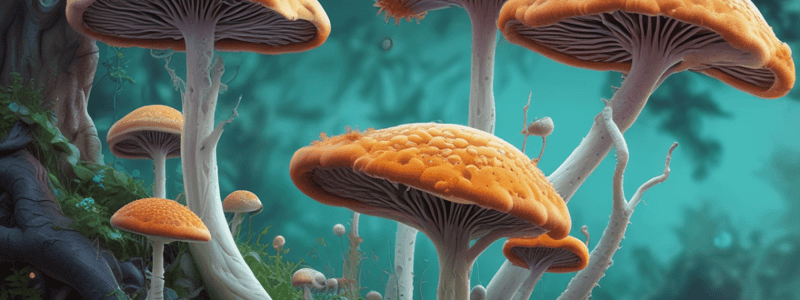Podcast
Questions and Answers
Which type of fungus is responsible for causing Tinea capitis?
Which type of fungus is responsible for causing Tinea capitis?
- Trichophyton
- Epidermophyton
- Candida
- Microsporum (correct)
Which of the following is NOT a type of dermatophyte fungus?
Which of the following is NOT a type of dermatophyte fungus?
- Trichophyton
- Epidermophyton
- Microsporum
- Candida (correct)
Which of the following is a subcutaneous mycosis disease caused by a dimorphic fungus?
Which of the following is a subcutaneous mycosis disease caused by a dimorphic fungus?
- Candidiasis
- Maduromycosis
- Sporotrichosis (correct)
- Chromoblastomycosis
What is the most common causative agent of Maduromycosis (Madura foot)?
What is the most common causative agent of Maduromycosis (Madura foot)?
Which of the following is a common clinical manifestation of Candidiasis?
Which of the following is a common clinical manifestation of Candidiasis?
What is the diagnostic feature for Sporotrichosis observed under the microscope?
What is the diagnostic feature for Sporotrichosis observed under the microscope?
Which of the following stains is used to detect mucinous substances in fungal infections?
Which of the following stains is used to detect mucinous substances in fungal infections?
Which of these fungal infections typically resolves without treatment in immunocompetent individuals?
Which of these fungal infections typically resolves without treatment in immunocompetent individuals?
What is the first-line treatment for progressive pulmonary disease and disseminated histoplasmosis?
What is the first-line treatment for progressive pulmonary disease and disseminated histoplasmosis?
Which of the following is a characteristic of the fungus that causes paracoccidioidomycosis?
Which of the following is a characteristic of the fungus that causes paracoccidioidomycosis?
Which of the following specimens is most commonly used for the laboratory diagnosis of systemic mycoses?
Which of the following specimens is most commonly used for the laboratory diagnosis of systemic mycoses?
What is the purpose of the 10% KOH preparation in the microscopic examination of fungal specimens?
What is the purpose of the 10% KOH preparation in the microscopic examination of fungal specimens?
Which of the following terms refers to hyphae that are located above the agar surface?
Which of the following terms refers to hyphae that are located above the agar surface?
Which term describes an asexual propagule formed by the breaking up of a hypha?
Which term describes an asexual propagule formed by the breaking up of a hypha?
What is the term used to describe a conidium formed by budding along a hypha, pseudohypha, or single cell, as in yeast?
What is the term used to describe a conidium formed by budding along a hypha, pseudohypha, or single cell, as in yeast?
Which term describes an enlarged, rounded conidium that is thick-walled and may be located at the end or along the hypha, singly or in chains?
Which term describes an enlarged, rounded conidium that is thick-walled and may be located at the end or along the hypha, singly or in chains?
What term is used to describe fungal structures that are brown to black due to the presence of melanotic pigment in the cell wall?
What term is used to describe fungal structures that are brown to black due to the presence of melanotic pigment in the cell wall?
Which term describes a process of asexual reproduction in which the new cell develops as a similar outgrowth from the older parent cell, as in yeast or yeast-like fungi?
Which term describes a process of asexual reproduction in which the new cell develops as a similar outgrowth from the older parent cell, as in yeast or yeast-like fungi?
Which of the following is NOT a cause of opportunistic mycoses?
Which of the following is NOT a cause of opportunistic mycoses?
Which of the following statements about actinomycetes is INCORRECT?
Which of the following statements about actinomycetes is INCORRECT?
Which of the following hyaline fungi could be a contaminant or implicated in infection?
Which of the following hyaline fungi could be a contaminant or implicated in infection?
Which of the following is NOT a characteristic of phaeohyphomycetes?
Which of the following is NOT a characteristic of phaeohyphomycetes?
Which of the following statements about hyphae is CORRECT?
Which of the following statements about hyphae is CORRECT?
Which of the following is NOT a type of asexual spore?
Which of the following is NOT a type of asexual spore?
What type of staining technique is commonly used for the identification of Histoplasma capsulatum?
What type of staining technique is commonly used for the identification of Histoplasma capsulatum?
At what temperature is the dimorphic, tuberculate macroconidia of Histoplasma capsulatum cultured?
At what temperature is the dimorphic, tuberculate macroconidia of Histoplasma capsulatum cultured?
Which of the following fungal infections is characterized by the presence of spherules with endospores upon microscopy?
Which of the following fungal infections is characterized by the presence of spherules with endospores upon microscopy?
What is the distinctive characteristic of Blastomyces dermatitidis seen under microscopy?
What is the distinctive characteristic of Blastomyces dermatitidis seen under microscopy?
Which staining technique is not commonly used for the identification of systemic mycoses?
Which staining technique is not commonly used for the identification of systemic mycoses?
Which fungal infection can be identified through a positive histoplasmin skin test indicating exposure only?
Which fungal infection can be identified through a positive histoplasmin skin test indicating exposure only?
Flashcards are hidden until you start studying




